AICE Marine A level chapters 6-7
5.0(1)
Card Sorting
1/78
There's no tags or description
Looks like no tags are added yet.
Study Analytics
Name | Mastery | Learn | Test | Matching | Spaced |
|---|
No study sessions yet.
79 Terms
1
New cards
what does a plant cell include?
* cell membrane
* nucleus
* rough + smooth ER
* Ribosomes
* golgi body
* mitochondria
* chloroplasts
* cell wall
* large permanent vacuole
* nucleus
* rough + smooth ER
* Ribosomes
* golgi body
* mitochondria
* chloroplasts
* cell wall
* large permanent vacuole
2
New cards
label plant cell
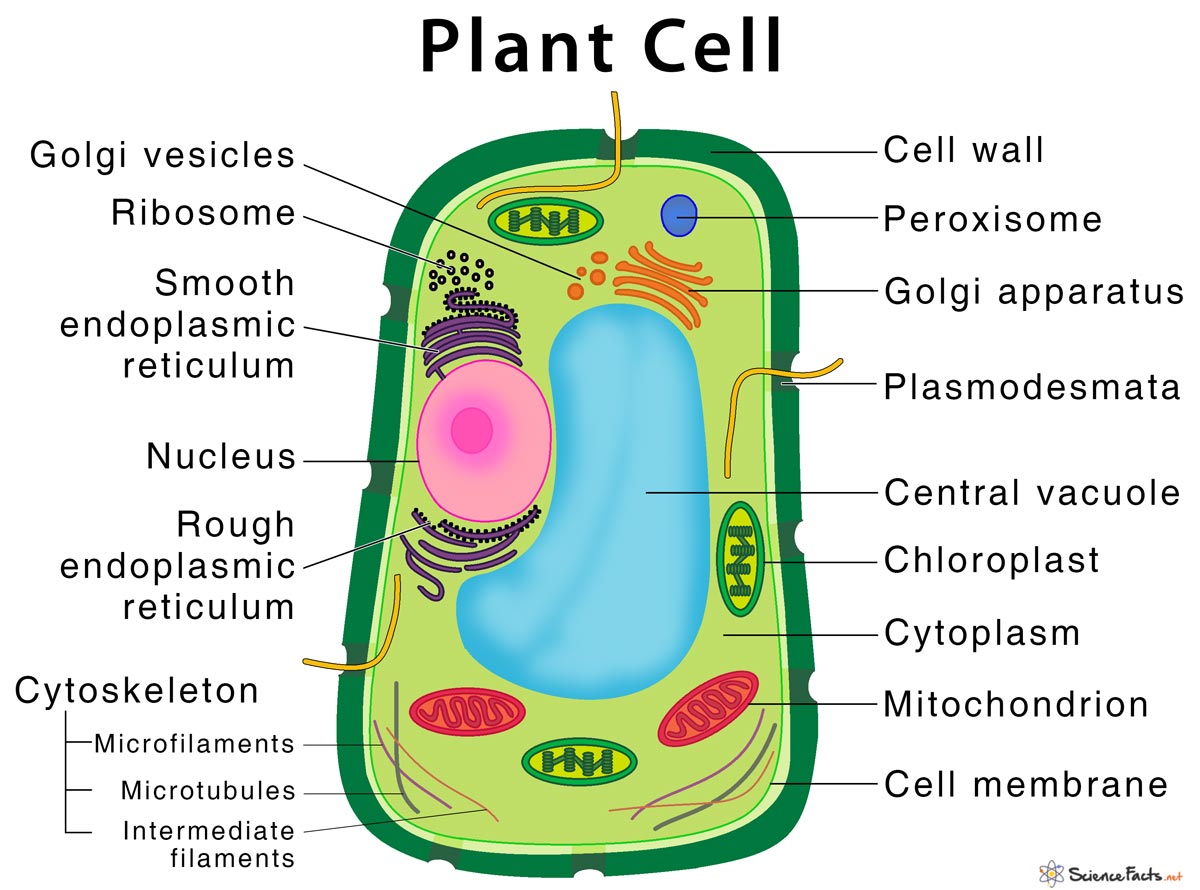
3
New cards
function of cell membrane
* boundary of a cell with its exterior
* controls the movement of substances in and out of the cell
* receives instructions from other cells
* controls the movement of substances in and out of the cell
* receives instructions from other cells
4
New cards
function of nucleus
* contains genetic material
5
New cards
function of rough ER
* majority of the ER
* has ribosomes on surface
* folds and packages proteins
* proteins are “budded off” in a vesicle and moved to Golgi
* has ribosomes on surface
* folds and packages proteins
* proteins are “budded off” in a vesicle and moved to Golgi
6
New cards
function of smooth ER
* less abundant
* no ribosomes
* synthesizes steroid hormones
* large amounts found in testicles and ovaries
* no ribosomes
* synthesizes steroid hormones
* large amounts found in testicles and ovaries
7
New cards
function of ribosomes
protein synthesis
8
New cards
function of golgi body
* chemical modification of proteins, such as adding carbohydrates
* produces substances needed for plant cell wall synthesis
* produces lysosomes
* produces substances needed for plant cell wall synthesis
* produces lysosomes
9
New cards
function of mitochondria
* produce ATP by aerobic respiration in animals and plants
* cells with high energy requirements have large amounts of mitochondria
* cells with high energy requirements have large amounts of mitochondria
10
New cards
function of chloroplast
* carry out photosynthesis
11
New cards
label chloroplast
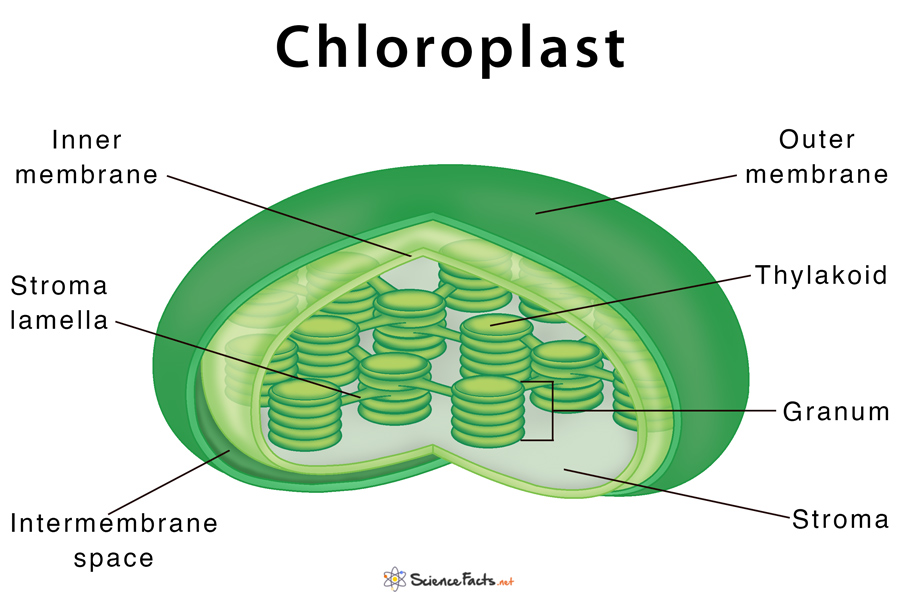
12
New cards
Stroma (in chloroplast)
* where light independent stage occurs
13
New cards
Thylakoid membrane (in chloroplast)
where light dependent stage occurs
14
New cards
Grana (in chloroplast)
stacked thylakoid membranes containing photosynthetic pigments; trap light energy
15
New cards
function of cell wall
* strength and support for whole plants
* preventing cells from bursting due to inflow of water
* only in plant cells
* made of cellulose
* preventing cells from bursting due to inflow of water
* only in plant cells
* made of cellulose
16
New cards
function of large permanent vacuole
* in plant cells
* stores pigments, water, and waste products
* stores pigments, water, and waste products
17
New cards
phospholipids
* fatty acid tail is uncharged (does not want water to enter)
* phosphate head is charged and hydrophilic (wants to enter water and dissolves in water)
* phosphate head is charged and hydrophilic (wants to enter water and dissolves in water)
18
New cards
carrier proteins
* possess specific binding site to which substances bind and change shape as the substance is moved across the membrane
19
New cards
channel proteins
* a pore through which substances will pass through
20
New cards
fluid mosaic model labeled
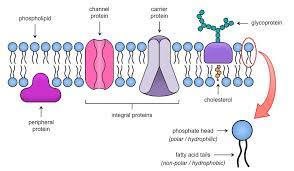
21
New cards
active transport
uses energy to pass molecules through carrier proteins
22
New cards
passive transport
* diffusion
* no additional energy input (small and non-polar like O2 and CO2 diffuse through phospholipid bilayer between fatty acid tails)
* no additional energy input (small and non-polar like O2 and CO2 diffuse through phospholipid bilayer between fatty acid tails)
23
New cards
labeled animal cell
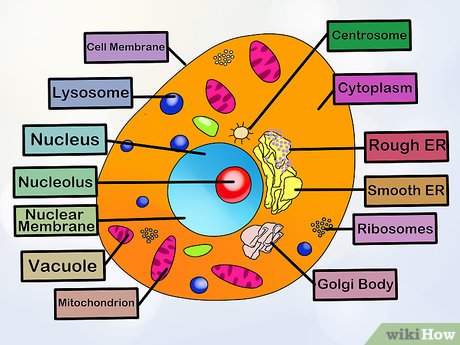
24
New cards
how to calculate magnification of an image
* measure the length of the image with a ruler
* ensure to have the same units for the image length and actual length
* use the formula for magnification by dividing the image length by the actual length
* ensure to have the same units for the image length and actual length
* use the formula for magnification by dividing the image length by the actual length

25
New cards
diffusion
the movement of molecules from high to low concentration (passive process = no additional input of energy)
26
New cards
facilitated diffusion
movement of molecules from high to low concentration through carrier or channel proteins
27
New cards
osmosis
diffusion of water (from higher to lower water potential)
28
New cards
active transport
* using energy (ATP) to move molecules across the cell membrane
* carrier proteins bind molecules to one side of membrane
* atp binds to carrier protein and is broken down to ADP and phosphate
* releases energy
* energy is used to change shape of protein to move the molecule across the membrane
* returns to original shape
* carrier proteins bind molecules to one side of membrane
* atp binds to carrier protein and is broken down to ADP and phosphate
* releases energy
* energy is used to change shape of protein to move the molecule across the membrane
* returns to original shape
29
New cards
water potential
potential energy of water in a solution compared to pure water; water will move by osmosis from high to low water potential
* the more water molecules, the higher the water potential
* if a solute such as salt is dissolved in water, the proportion of water molecules in the solution decreases water potential
* the more water molecules, the higher the water potential
* if a solute such as salt is dissolved in water, the proportion of water molecules in the solution decreases water potential
30
New cards
hypertonic
solution has greater concentration of solutes
* lower water potential than the cells/body fluids of an organism
* lower water potential than the cells/body fluids of an organism
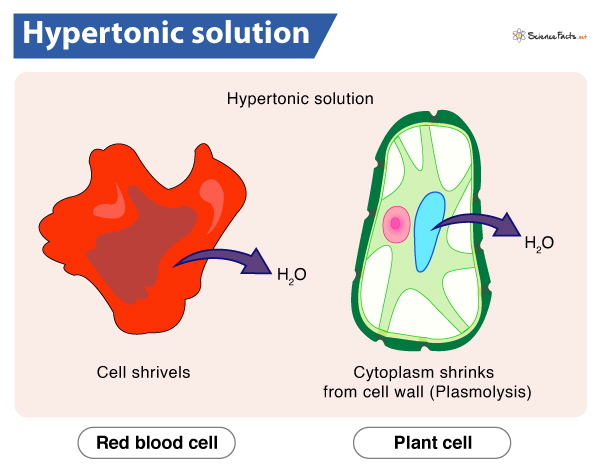
31
New cards
isotonic
solution has greater concentration of solutes
* lower water potential than the cells/ body fluids of organism
* lower water potential than the cells/ body fluids of organism
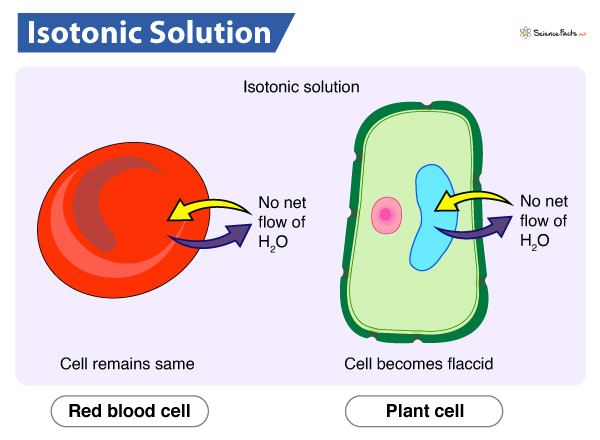
32
New cards
hypotonic
solution has lower solute concentration
* higher water potential than cells/body fluids of organism
* higher water potential than cells/body fluids of organism
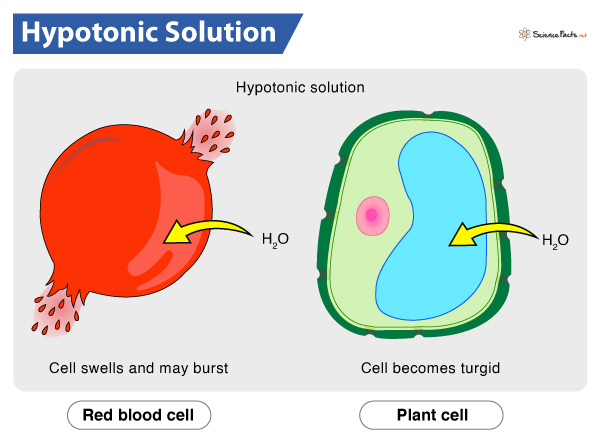
33
New cards
smaller organisms/cells have a larger or smaller SA:volume ratio?
larger
34
New cards
Larger SA:Volume ratio =
faster rate of diffusion
35
New cards
why do larger organisms need gills or lungs
for diffusion
36
New cards
increased surface area (like tentacles or coral polyps) =
increased area through which gases can diffuse
37
New cards
gills
* gill arches hold gill filaments
* gill filaments have a number of lamellae
* lamellae increase the gas exchange surface area
* gill filaments have a number of lamellae
* lamellae increase the gas exchange surface area
38
New cards
Gill hyperplasia
* Shortening, rounding, and fusion of gill lamellae
* increases mucus production
* reduces surface area for gas exchange
* increases mucus production
* reduces surface area for gas exchange
39
New cards
circulatory system in a typical fish
1. blood passes through muscles and other body tissues and releases O2→picks up Co2
2. blood pumped back to the heart (through veins)
3. blood pumped from heart to gills (through arteries)
4. blood passes through gills (capillaries) + releases CO2 and picks up O2
5. Blood leaves gills (in arteries) and travels to muscles and other body tissues
6. to deliver O2 and remove CO2
40
New cards
what organisms use simple diffusion
small animals and/or animals with thin/few tissue layers
* coral polyps
* coral polyps
41
New cards
pumped ventilation
* demersal and slow swimming fishes (ex. grouper)
1. Open mouth, close operculum, creates a low pressure in the buccal cavity, draws water in
2. close mouth, open opercula, increases pressure in the buccal cavity, pushes water out through the gills (diffuse O2 in and CO2 out)
1. Open mouth, close operculum, creates a low pressure in the buccal cavity, draws water in
2. close mouth, open opercula, increases pressure in the buccal cavity, pushes water out through the gills (diffuse O2 in and CO2 out)
42
New cards
ram ventilation
* pelagic fishes (constant swimmers; have higher o2 demand) ex. tuna
* swim continuously, with mouth open, so water constantly flows in through the mouth and over the gills to diffuse O2 in and CO2 out
* swim continuously, with mouth open, so water constantly flows in through the mouth and over the gills to diffuse O2 in and CO2 out
43
New cards
why do marine organisms need to regulate their water content and ion content
if they live in an environment with high salinity and low water potential
44
New cards
osmoconformer
* organism with the same internal solute concentration/water potential as surrounding water
* ex. mussels
* when salinity changes, mussels close shells to prevent seawater coming into contact with body tissue
* can increase and decrease solute concentrations of their cells if external salinity changes
* ex. mussels
* when salinity changes, mussels close shells to prevent seawater coming into contact with body tissue
* can increase and decrease solute concentrations of their cells if external salinity changes
45
New cards
osmoregulator
* organism that maintains internal solute concentration (body fluids)
* Ex. salmon, tuna, bull shark
* salmon migrate from freshwater to the ocean and maintain their internal solute concentration
* tuna live off shore their entire lives, where salinity doesn’t change
* bull sharks (juveniles) migrate from the ocean into freshwater rivers
* Ex. salmon, tuna, bull shark
* salmon migrate from freshwater to the ocean and maintain their internal solute concentration
* tuna live off shore their entire lives, where salinity doesn’t change
* bull sharks (juveniles) migrate from the ocean into freshwater rivers
46
New cards
euryhaline
* organisms that can tolerate a WIDE range of salinities
* ex. salmon, bull sharks, and mussels
\
* ex. salmon, bull sharks, and mussels
\
47
New cards
stenohaline
* organisms that can tolerate only a NARROW range of salinities
* ex. tuna
* ex. tuna
48
New cards
Osmoregulation characteristics in marine fishes
* surrounding water typically has higher salinity than their cells and body fluids
* constantly drink seawater to replace water lost by osmosis
* Sodium and chlorine ions are actively secreted by the gills. Specialized cells on the gill filaments have protein “pumps” that pump ions into the water; uses ATP
* magnesium and sulfate ions are actively secreted by the kidney into urine
* reabsorption of water by the kidney produces a low volume of very concentrated urine
* constantly drink seawater to replace water lost by osmosis
* Sodium and chlorine ions are actively secreted by the gills. Specialized cells on the gill filaments have protein “pumps” that pump ions into the water; uses ATP
* magnesium and sulfate ions are actively secreted by the kidney into urine
* reabsorption of water by the kidney produces a low volume of very concentrated urine
49
New cards
osmoregulation characteristics in freshwater fishes
* surrounding water has lower salinity and higher water potential than their cells and body fluids
* drink small amounts of water
* gills actively pump sodium and chloride ions into blood and body fluid. specialized cells have protein pumps that actively pump the ions from the external water to the internal body fluids; uses ATP
* produce large amounts of very dilute urine
* drink small amounts of water
* gills actively pump sodium and chloride ions into blood and body fluid. specialized cells have protein pumps that actively pump the ions from the external water to the internal body fluids; uses ATP
* produce large amounts of very dilute urine
50
New cards
electromagnetic spectrum
from left to right:
* gamma rays
* x-rays
* ultraviolet light
* visible light
* infrared
* radio waves
* gamma rays
* x-rays
* ultraviolet light
* visible light
* infrared
* radio waves
51
New cards
light wavelength
the wavelength/visible color of light in nm
52
New cards
light intensity
measure of strength or brightness of light
53
New cards
light penetration
depth at which light can penetrate through water
54
New cards
red light
* penetrates into the most shallow waters - down to 10 m
* as it is absorbed by the surface water
* longest wavelength (620-720nm)
* as it is absorbed by the surface water
* longest wavelength (620-720nm)
55
New cards
blue light
* penetrates the deepest - down to 200 m
* short wavelength
* short wavelength
56
New cards
green light
* penetrates depths deeper than red, but shallower than blue
57
New cards
photosynthesis number equation
6co2 + 6H20 → C6H12O6 + 6O2
58
New cards
light dependent stage
* takes place in grana of the thylakoid membranes
* trap light energy and transform into chemical energy used to produce glucose
* grana contain primary and accessory pigments embedded in their membranes in clusters called photosystems
* when chlorophyll a (primary pigment) absorbs light energy it undergoes photoactivation
* the molecule loses an electron; it is oxidised (losing electrons: oxidation, gaining electrons: reduction)
* b/c the electron loss was due to the trapping of light (photooxidation)
* trap light energy and transform into chemical energy used to produce glucose
* grana contain primary and accessory pigments embedded in their membranes in clusters called photosystems
* when chlorophyll a (primary pigment) absorbs light energy it undergoes photoactivation
* the molecule loses an electron; it is oxidised (losing electrons: oxidation, gaining electrons: reduction)
* b/c the electron loss was due to the trapping of light (photooxidation)
59
New cards
summary of light-dependent stage
* function : harvest light energy and convert to chemical energy
* energy is given to 2 molecules, ATP and reduced NADP
* photolysis of water provides electrons to replace those lost by oxidized chlorophyll a
* oxygen is released as a byproduct of photolysis
* energy is given to 2 molecules, ATP and reduced NADP
* photolysis of water provides electrons to replace those lost by oxidized chlorophyll a
* oxygen is released as a byproduct of photolysis
60
New cards
light-independent stage
* 2nd stage of photosynthesis
* the energy (ATP and reduced NADP) that has been harvested in the light dependent stage is used to make glucose by carbon dioxide fixation
* takes place in the stroma of the chloroplast
* calvin cycle makes glucose
* carbon containing molecules are converted through a range of different forms
* the energy (ATP and reduced NADP) that has been harvested in the light dependent stage is used to make glucose by carbon dioxide fixation
* takes place in the stroma of the chloroplast
* calvin cycle makes glucose
* carbon containing molecules are converted through a range of different forms
61
New cards
calvin cycle
* carbon dioxide is combined with RuBP by enzyme rubisco
* Joining carbon dioxide and RuBP makes a sugar with 6 carbon atoms which breaks into GP
* GP is converted into a diff sugar called TP which produces glucose from ATP and NADPH
* some of the TP is used to make glucose while the rest is used to make new sugar called RuP
* RuP is given another phosphate by more ATP to make RuBP. The RuBP can then repeat the calvin cycle with fresh carbon dioxide
* Joining carbon dioxide and RuBP makes a sugar with 6 carbon atoms which breaks into GP
* GP is converted into a diff sugar called TP which produces glucose from ATP and NADPH
* some of the TP is used to make glucose while the rest is used to make new sugar called RuP
* RuP is given another phosphate by more ATP to make RuBP. The RuBP can then repeat the calvin cycle with fresh carbon dioxide
62
New cards
light independent stage summarized
* uses the energy from ATP and reduced NADP that were produced in the light dependent stage
* enzyme rubisco combines carbon dioxide with RuBP
* it fixes carbon dioxide and makes glucose
* energy from light ends up in the glucose
* enzyme rubisco combines carbon dioxide with RuBP
* it fixes carbon dioxide and makes glucose
* energy from light ends up in the glucose
63
New cards
chloroplast pigments
* absorbs blue and red
* organisms that are green live in the shallowest depths (to absorb red light)
* carotenoids absorb blue
* organisms that are yellow/brown/orange live deeper
* fucoxanthin absorbs blue and green
* phycocyanin (blue-green) absorbs orange, yellow and green
* Phycoerythrin absorbs blue and green
* organisms that are green live in the shallowest depths (to absorb red light)
* carotenoids absorb blue
* organisms that are yellow/brown/orange live deeper
* fucoxanthin absorbs blue and green
* phycocyanin (blue-green) absorbs orange, yellow and green
* Phycoerythrin absorbs blue and green
64
New cards
green algae and seagrass live in
shallowest water
65
New cards
blue-green (contains phycocyanin) bacteria live in
deeper water
66
New cards
brown/yellow/orange algae (kelp, dinoflagellates, etc) live
deeper than green
67
New cards
red algae lives
in the deepest, but still shallow water bc they need sun for photosynthesis
68
New cards
69
New cards
red and brown algae live
at deeper depths
70
New cards
why do pigments live at varying depths
based on their absorption spectra to REDUCE COMPETITION
71
New cards
effect of light intensity on rate of photosynthesis
increases then stabilizes bc another factor becomes limited
72
New cards
effect of carbon dioxide concentration on rate of photosynthesis
increases then stabilizes bc another factor becomes limiting
73
New cards
effect of temperature on the rate of photosynthesis
increases then falls bc enzymes denature
74
New cards
chemosynthesis
the fixation of carbon using the chemical energy of dissolved substances
75
New cards
chemosynthesis formula
12H2S + 6CO2 → C6H12O6 + 6H2O + 12S
hydrogen sulfide + carbon dioxide → glucose + water + sulfur
hydrogen sulfide + carbon dioxide → glucose + water + sulfur
76
New cards
endoriftia and riftia
* mutualism
* endoriftia lives in riftia’s trophosome
* using their plume (external gills) riftia takes in H2S for Endoriftia to chemosynthesize
* Endoriftia produce glucose and other organic molecules
* Endoriftia get constant supply of H2S for chemosynthesis
* endoriftia lives in riftia’s trophosome
* using their plume (external gills) riftia takes in H2S for Endoriftia to chemosynthesize
* Endoriftia produce glucose and other organic molecules
* Endoriftia get constant supply of H2S for chemosynthesis
77
New cards
aerobic respiration
* energy is released from glucose by oxidation, producing carbon dioxide and water as waste products
* aerobic=uses oxygen
* energy released is ATP
* begins in cytoplasm, continues in mitochondria
* 1 molecule of glucose produces up to 38 molecules of ATP
* aerobic=uses oxygen
* energy released is ATP
* begins in cytoplasm, continues in mitochondria
* 1 molecule of glucose produces up to 38 molecules of ATP
78
New cards
anaerobic respiration
* without oxygen
* incomplete combustion of glucose
* 1 glucose molecule generates only 2 molecules of ATP
* occurs in cytoplasm
\
* incomplete combustion of glucose
* 1 glucose molecule generates only 2 molecules of ATP
* occurs in cytoplasm
\
79
New cards